Taxation Law HA3042: Personal Exertion Income Analysis - T1 2018
VerifiedAdded on 2023/06/11
|13
|3143
|345
Homework Assignment
AI Summary
This assignment provides solutions to taxation law questions, focusing on income from personal exertion, assessable ordinary income, and capital gains tax (CGT). It analyzes scenarios involving a mountain climber's income from media rights and manuscript sales, interest earned on a loan, and the CGT implications of selling a property. The solutions reference relevant sections of the ITAA 1997 and relevant case law to determine tax liabilities. The document is available on Desklib, a platform that provides students with access to past papers and solved assignments.
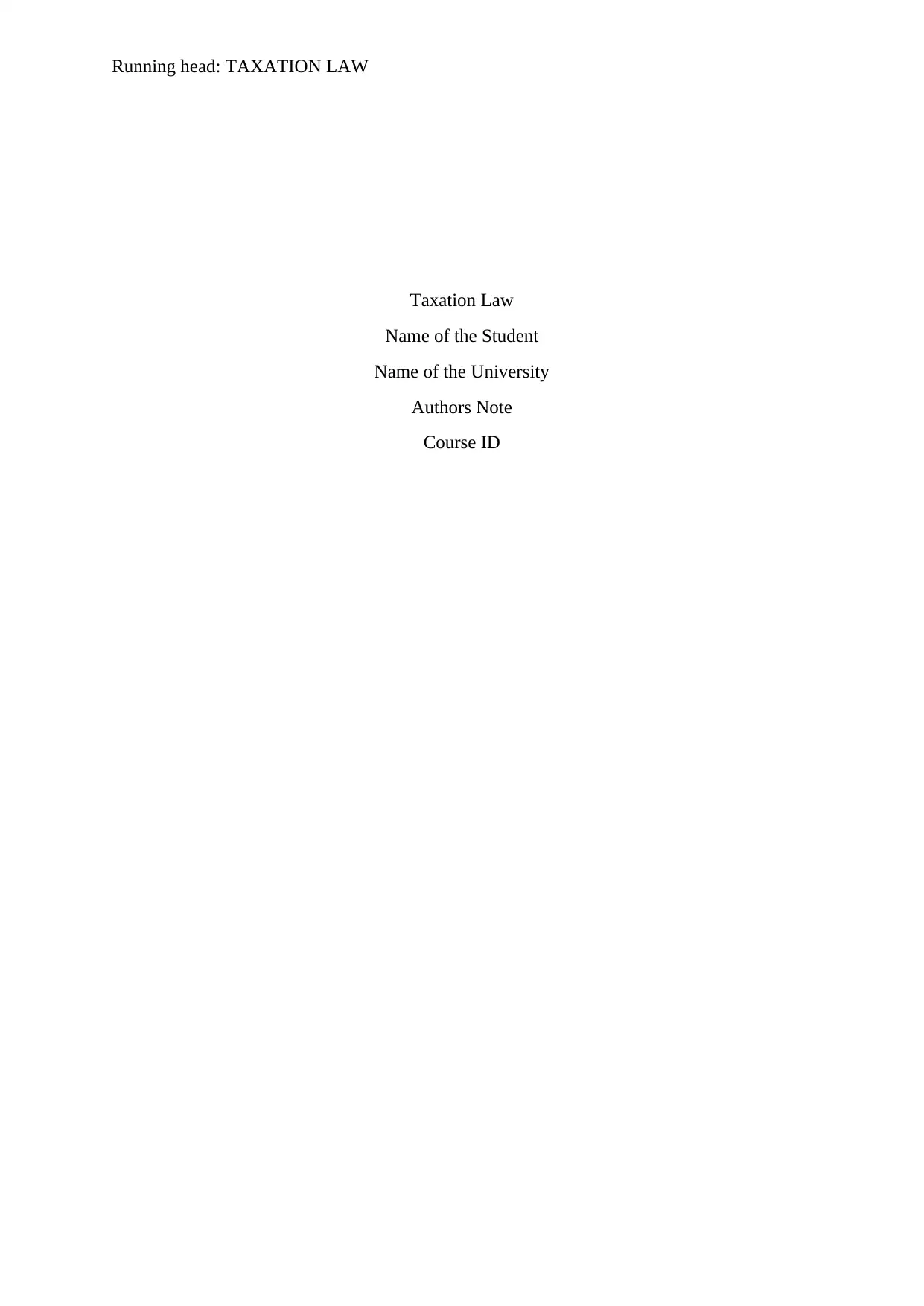
Running head: TAXATION LAW
Taxation Law
Name of the Student
Name of the University
Authors Note
Course ID
Taxation Law
Name of the Student
Name of the University
Authors Note
Course ID
Paraphrase This Document
Need a fresh take? Get an instant paraphrase of this document with our AI Paraphraser
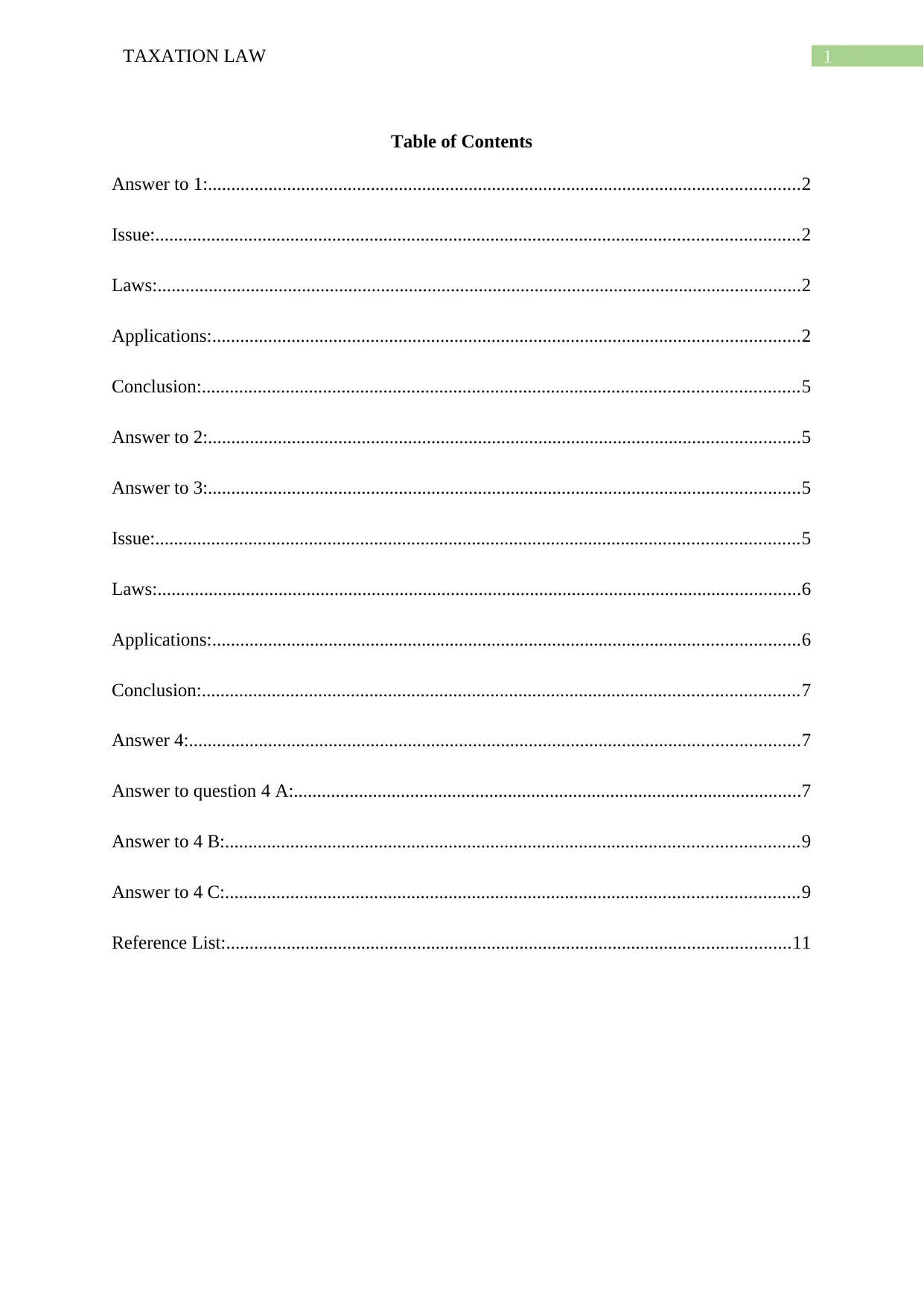
1TAXATION LAW
Table of Contents
Answer to 1:...............................................................................................................................2
Issue:..........................................................................................................................................2
Laws:..........................................................................................................................................2
Applications:..............................................................................................................................2
Conclusion:................................................................................................................................5
Answer to 2:...............................................................................................................................5
Answer to 3:...............................................................................................................................5
Issue:..........................................................................................................................................5
Laws:..........................................................................................................................................6
Applications:..............................................................................................................................6
Conclusion:................................................................................................................................7
Answer 4:...................................................................................................................................7
Answer to question 4 A:.............................................................................................................7
Answer to 4 B:...........................................................................................................................9
Answer to 4 C:...........................................................................................................................9
Reference List:.........................................................................................................................11
Table of Contents
Answer to 1:...............................................................................................................................2
Issue:..........................................................................................................................................2
Laws:..........................................................................................................................................2
Applications:..............................................................................................................................2
Conclusion:................................................................................................................................5
Answer to 2:...............................................................................................................................5
Answer to 3:...............................................................................................................................5
Issue:..........................................................................................................................................5
Laws:..........................................................................................................................................6
Applications:..............................................................................................................................6
Conclusion:................................................................................................................................7
Answer 4:...................................................................................................................................7
Answer to question 4 A:.............................................................................................................7
Answer to 4 B:...........................................................................................................................9
Answer to 4 C:...........................................................................................................................9
Reference List:.........................................................................................................................11
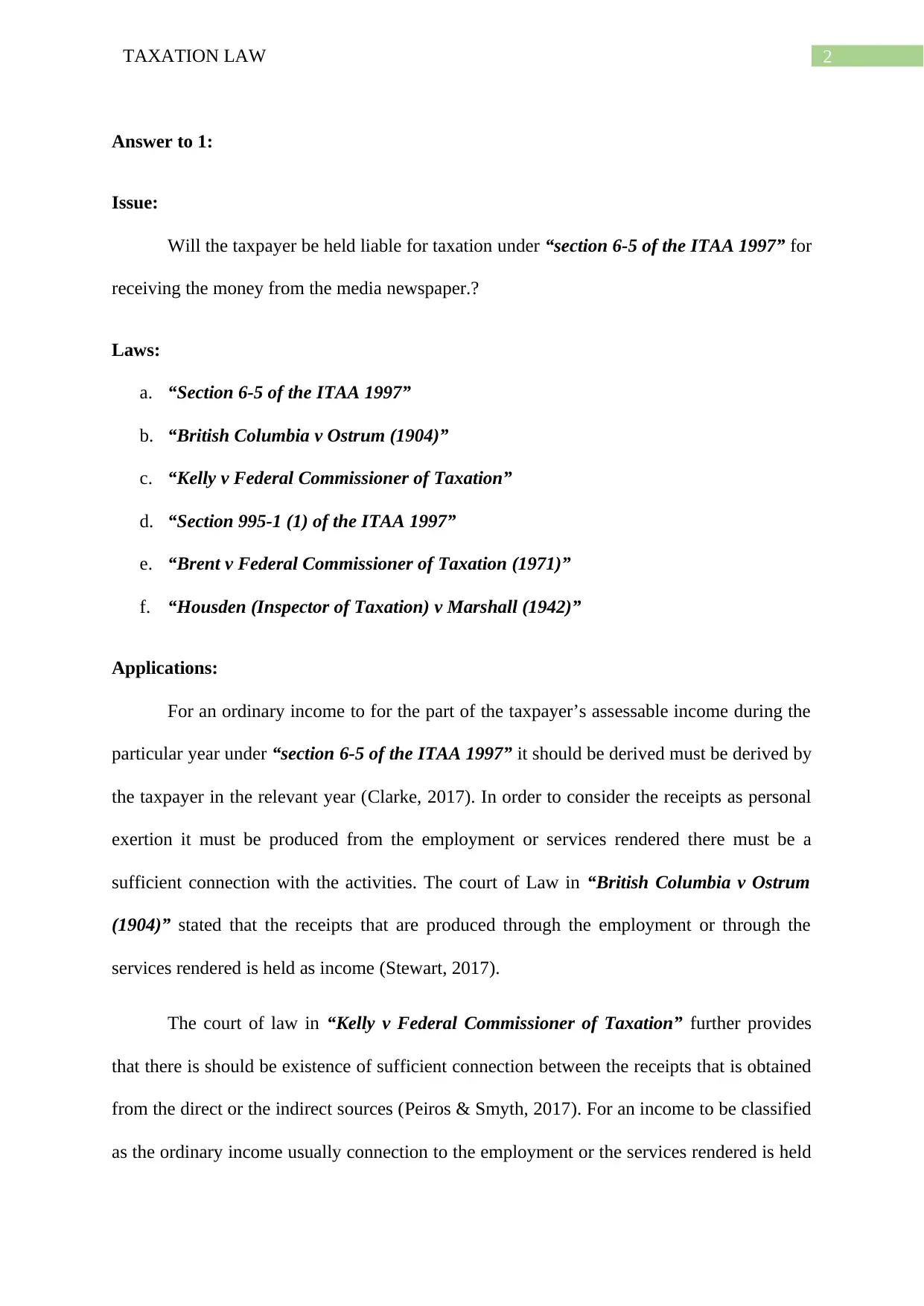
2TAXATION LAW
Answer to 1:
Issue:
Will the taxpayer be held liable for taxation under “section 6-5 of the ITAA 1997” for
receiving the money from the media newspaper.?
Laws:
a. “Section 6-5 of the ITAA 1997”
b. “British Columbia v Ostrum (1904)”
c. “Kelly v Federal Commissioner of Taxation”
d. “Section 995-1 (1) of the ITAA 1997”
e. “Brent v Federal Commissioner of Taxation (1971)”
f. “Housden (Inspector of Taxation) v Marshall (1942)”
Applications:
For an ordinary income to for the part of the taxpayer’s assessable income during the
particular year under “section 6-5 of the ITAA 1997” it should be derived must be derived by
the taxpayer in the relevant year (Clarke, 2017). In order to consider the receipts as personal
exertion it must be produced from the employment or services rendered there must be a
sufficient connection with the activities. The court of Law in “British Columbia v Ostrum
(1904)” stated that the receipts that are produced through the employment or through the
services rendered is held as income (Stewart, 2017).
The court of law in “Kelly v Federal Commissioner of Taxation” further provides
that there is should be existence of sufficient connection between the receipts that is obtained
from the direct or the indirect sources (Peiros & Smyth, 2017). For an income to be classified
as the ordinary income usually connection to the employment or the services rendered is held
Answer to 1:
Issue:
Will the taxpayer be held liable for taxation under “section 6-5 of the ITAA 1997” for
receiving the money from the media newspaper.?
Laws:
a. “Section 6-5 of the ITAA 1997”
b. “British Columbia v Ostrum (1904)”
c. “Kelly v Federal Commissioner of Taxation”
d. “Section 995-1 (1) of the ITAA 1997”
e. “Brent v Federal Commissioner of Taxation (1971)”
f. “Housden (Inspector of Taxation) v Marshall (1942)”
Applications:
For an ordinary income to for the part of the taxpayer’s assessable income during the
particular year under “section 6-5 of the ITAA 1997” it should be derived must be derived by
the taxpayer in the relevant year (Clarke, 2017). In order to consider the receipts as personal
exertion it must be produced from the employment or services rendered there must be a
sufficient connection with the activities. The court of Law in “British Columbia v Ostrum
(1904)” stated that the receipts that are produced through the employment or through the
services rendered is held as income (Stewart, 2017).
The court of law in “Kelly v Federal Commissioner of Taxation” further provides
that there is should be existence of sufficient connection between the receipts that is obtained
from the direct or the indirect sources (Peiros & Smyth, 2017). For an income to be classified
as the ordinary income usually connection to the employment or the services rendered is held
⊘ This is a preview!⊘
Do you want full access?
Subscribe today to unlock all pages.

Trusted by 1+ million students worldwide
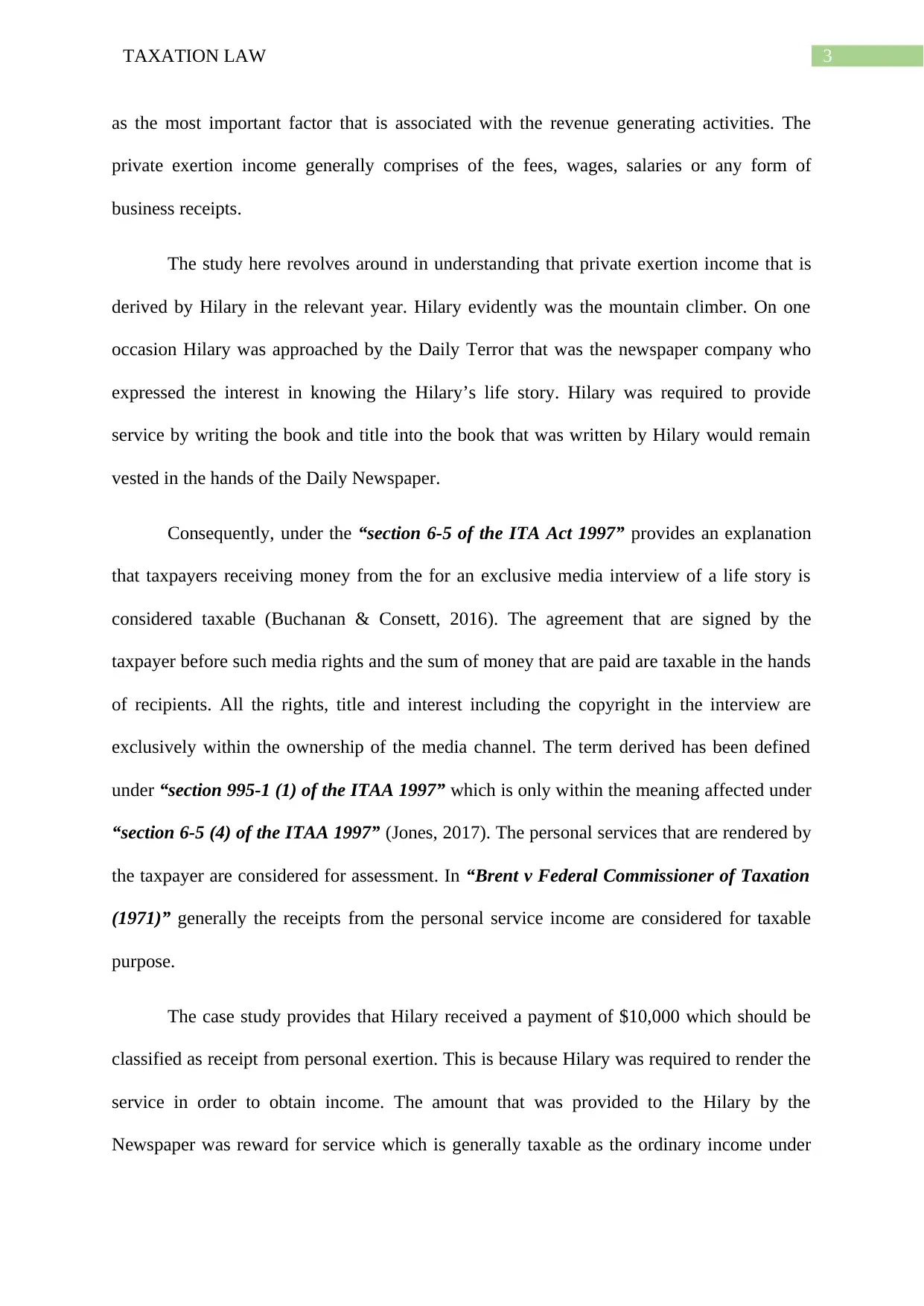
3TAXATION LAW
as the most important factor that is associated with the revenue generating activities. The
private exertion income generally comprises of the fees, wages, salaries or any form of
business receipts.
The study here revolves around in understanding that private exertion income that is
derived by Hilary in the relevant year. Hilary evidently was the mountain climber. On one
occasion Hilary was approached by the Daily Terror that was the newspaper company who
expressed the interest in knowing the Hilary’s life story. Hilary was required to provide
service by writing the book and title into the book that was written by Hilary would remain
vested in the hands of the Daily Newspaper.
Consequently, under the “section 6-5 of the ITA Act 1997” provides an explanation
that taxpayers receiving money from the for an exclusive media interview of a life story is
considered taxable (Buchanan & Consett, 2016). The agreement that are signed by the
taxpayer before such media rights and the sum of money that are paid are taxable in the hands
of recipients. All the rights, title and interest including the copyright in the interview are
exclusively within the ownership of the media channel. The term derived has been defined
under “section 995-1 (1) of the ITAA 1997” which is only within the meaning affected under
“section 6-5 (4) of the ITAA 1997” (Jones, 2017). The personal services that are rendered by
the taxpayer are considered for assessment. In “Brent v Federal Commissioner of Taxation
(1971)” generally the receipts from the personal service income are considered for taxable
purpose.
The case study provides that Hilary received a payment of $10,000 which should be
classified as receipt from personal exertion. This is because Hilary was required to render the
service in order to obtain income. The amount that was provided to the Hilary by the
Newspaper was reward for service which is generally taxable as the ordinary income under
as the most important factor that is associated with the revenue generating activities. The
private exertion income generally comprises of the fees, wages, salaries or any form of
business receipts.
The study here revolves around in understanding that private exertion income that is
derived by Hilary in the relevant year. Hilary evidently was the mountain climber. On one
occasion Hilary was approached by the Daily Terror that was the newspaper company who
expressed the interest in knowing the Hilary’s life story. Hilary was required to provide
service by writing the book and title into the book that was written by Hilary would remain
vested in the hands of the Daily Newspaper.
Consequently, under the “section 6-5 of the ITA Act 1997” provides an explanation
that taxpayers receiving money from the for an exclusive media interview of a life story is
considered taxable (Buchanan & Consett, 2016). The agreement that are signed by the
taxpayer before such media rights and the sum of money that are paid are taxable in the hands
of recipients. All the rights, title and interest including the copyright in the interview are
exclusively within the ownership of the media channel. The term derived has been defined
under “section 995-1 (1) of the ITAA 1997” which is only within the meaning affected under
“section 6-5 (4) of the ITAA 1997” (Jones, 2017). The personal services that are rendered by
the taxpayer are considered for assessment. In “Brent v Federal Commissioner of Taxation
(1971)” generally the receipts from the personal service income are considered for taxable
purpose.
The case study provides that Hilary received a payment of $10,000 which should be
classified as receipt from personal exertion. This is because Hilary was required to render the
service in order to obtain income. The amount that was provided to the Hilary by the
Newspaper was reward for service which is generally taxable as the ordinary income under
Paraphrase This Document
Need a fresh take? Get an instant paraphrase of this document with our AI Paraphraser
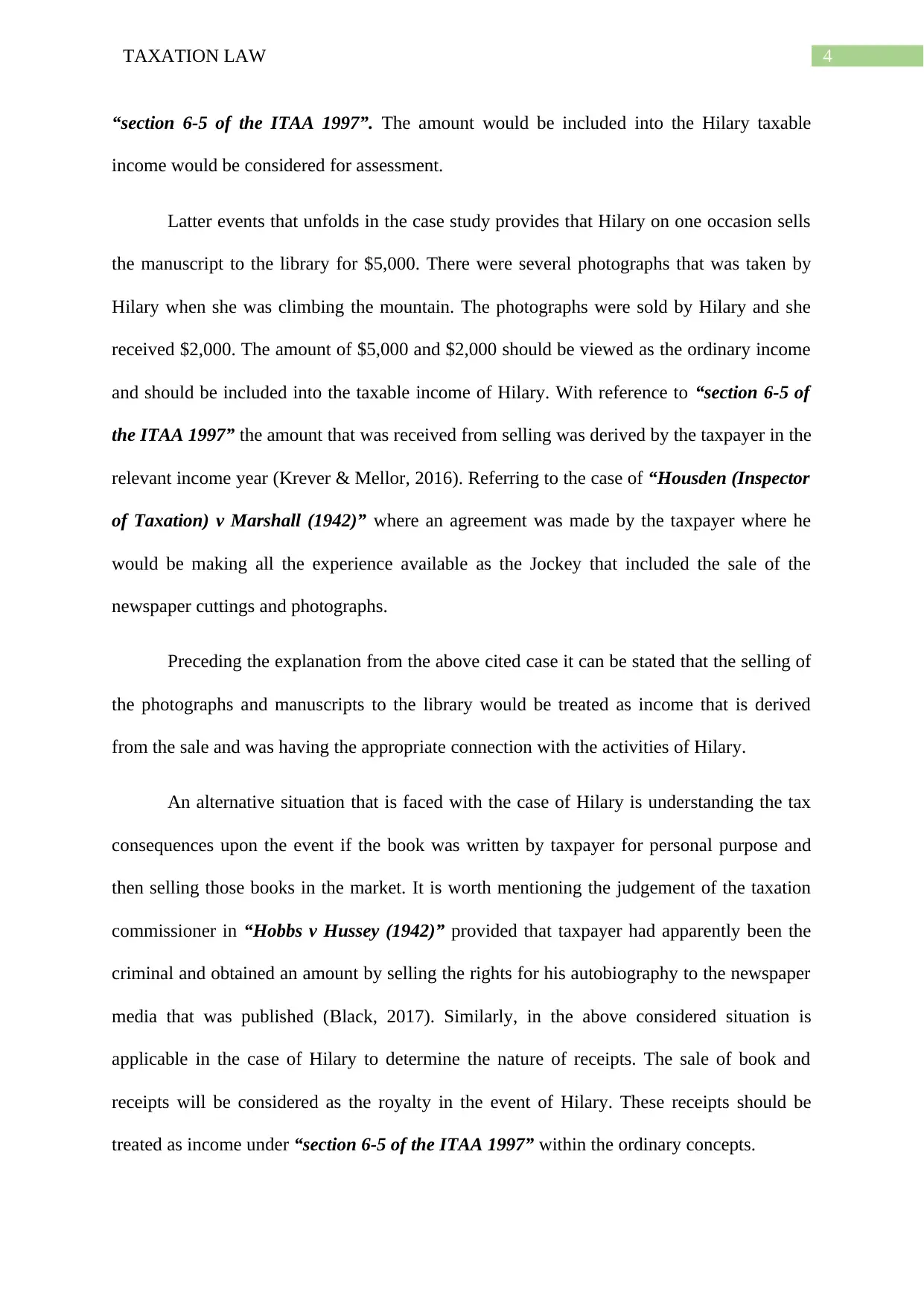
4TAXATION LAW
“section 6-5 of the ITAA 1997”. The amount would be included into the Hilary taxable
income would be considered for assessment.
Latter events that unfolds in the case study provides that Hilary on one occasion sells
the manuscript to the library for $5,000. There were several photographs that was taken by
Hilary when she was climbing the mountain. The photographs were sold by Hilary and she
received $2,000. The amount of $5,000 and $2,000 should be viewed as the ordinary income
and should be included into the taxable income of Hilary. With reference to “section 6-5 of
the ITAA 1997” the amount that was received from selling was derived by the taxpayer in the
relevant income year (Krever & Mellor, 2016). Referring to the case of “Housden (Inspector
of Taxation) v Marshall (1942)” where an agreement was made by the taxpayer where he
would be making all the experience available as the Jockey that included the sale of the
newspaper cuttings and photographs.
Preceding the explanation from the above cited case it can be stated that the selling of
the photographs and manuscripts to the library would be treated as income that is derived
from the sale and was having the appropriate connection with the activities of Hilary.
An alternative situation that is faced with the case of Hilary is understanding the tax
consequences upon the event if the book was written by taxpayer for personal purpose and
then selling those books in the market. It is worth mentioning the judgement of the taxation
commissioner in “Hobbs v Hussey (1942)” provided that taxpayer had apparently been the
criminal and obtained an amount by selling the rights for his autobiography to the newspaper
media that was published (Black, 2017). Similarly, in the above considered situation is
applicable in the case of Hilary to determine the nature of receipts. The sale of book and
receipts will be considered as the royalty in the event of Hilary. These receipts should be
treated as income under “section 6-5 of the ITAA 1997” within the ordinary concepts.
“section 6-5 of the ITAA 1997”. The amount would be included into the Hilary taxable
income would be considered for assessment.
Latter events that unfolds in the case study provides that Hilary on one occasion sells
the manuscript to the library for $5,000. There were several photographs that was taken by
Hilary when she was climbing the mountain. The photographs were sold by Hilary and she
received $2,000. The amount of $5,000 and $2,000 should be viewed as the ordinary income
and should be included into the taxable income of Hilary. With reference to “section 6-5 of
the ITAA 1997” the amount that was received from selling was derived by the taxpayer in the
relevant income year (Krever & Mellor, 2016). Referring to the case of “Housden (Inspector
of Taxation) v Marshall (1942)” where an agreement was made by the taxpayer where he
would be making all the experience available as the Jockey that included the sale of the
newspaper cuttings and photographs.
Preceding the explanation from the above cited case it can be stated that the selling of
the photographs and manuscripts to the library would be treated as income that is derived
from the sale and was having the appropriate connection with the activities of Hilary.
An alternative situation that is faced with the case of Hilary is understanding the tax
consequences upon the event if the book was written by taxpayer for personal purpose and
then selling those books in the market. It is worth mentioning the judgement of the taxation
commissioner in “Hobbs v Hussey (1942)” provided that taxpayer had apparently been the
criminal and obtained an amount by selling the rights for his autobiography to the newspaper
media that was published (Black, 2017). Similarly, in the above considered situation is
applicable in the case of Hilary to determine the nature of receipts. The sale of book and
receipts will be considered as the royalty in the event of Hilary. These receipts should be
treated as income under “section 6-5 of the ITAA 1997” within the ordinary concepts.
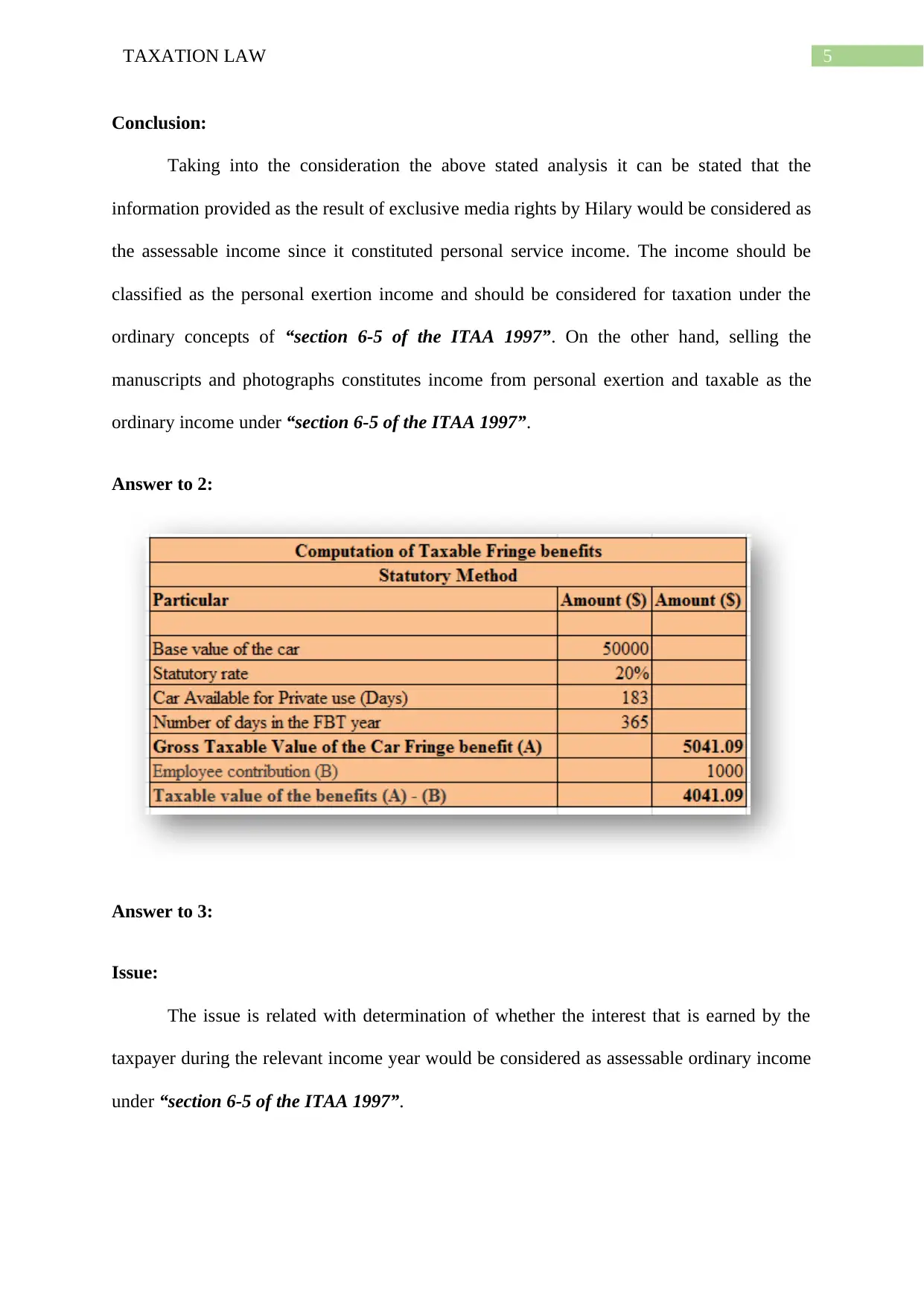
5TAXATION LAW
Conclusion:
Taking into the consideration the above stated analysis it can be stated that the
information provided as the result of exclusive media rights by Hilary would be considered as
the assessable income since it constituted personal service income. The income should be
classified as the personal exertion income and should be considered for taxation under the
ordinary concepts of “section 6-5 of the ITAA 1997”. On the other hand, selling the
manuscripts and photographs constitutes income from personal exertion and taxable as the
ordinary income under “section 6-5 of the ITAA 1997”.
Answer to 2:
Answer to 3:
Issue:
The issue is related with determination of whether the interest that is earned by the
taxpayer during the relevant income year would be considered as assessable ordinary income
under “section 6-5 of the ITAA 1997”.
Conclusion:
Taking into the consideration the above stated analysis it can be stated that the
information provided as the result of exclusive media rights by Hilary would be considered as
the assessable income since it constituted personal service income. The income should be
classified as the personal exertion income and should be considered for taxation under the
ordinary concepts of “section 6-5 of the ITAA 1997”. On the other hand, selling the
manuscripts and photographs constitutes income from personal exertion and taxable as the
ordinary income under “section 6-5 of the ITAA 1997”.
Answer to 2:
Answer to 3:
Issue:
The issue is related with determination of whether the interest that is earned by the
taxpayer during the relevant income year would be considered as assessable ordinary income
under “section 6-5 of the ITAA 1997”.
⊘ This is a preview!⊘
Do you want full access?
Subscribe today to unlock all pages.

Trusted by 1+ million students worldwide
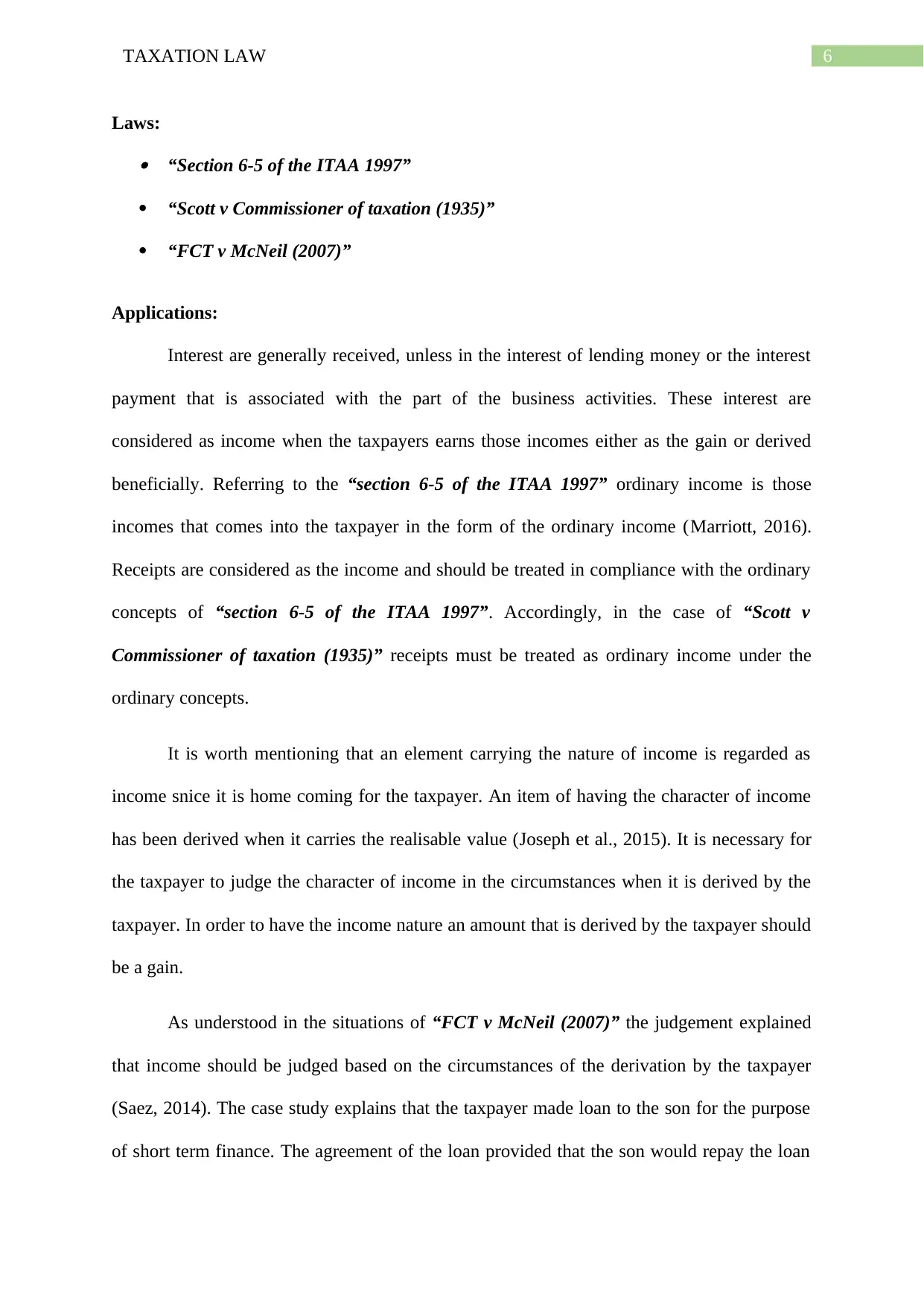
6TAXATION LAW
Laws: “Section 6-5 of the ITAA 1997”
“Scott v Commissioner of taxation (1935)”
“FCT v McNeil (2007)”
Applications:
Interest are generally received, unless in the interest of lending money or the interest
payment that is associated with the part of the business activities. These interest are
considered as income when the taxpayers earns those incomes either as the gain or derived
beneficially. Referring to the “section 6-5 of the ITAA 1997” ordinary income is those
incomes that comes into the taxpayer in the form of the ordinary income (Marriott, 2016).
Receipts are considered as the income and should be treated in compliance with the ordinary
concepts of “section 6-5 of the ITAA 1997”. Accordingly, in the case of “Scott v
Commissioner of taxation (1935)” receipts must be treated as ordinary income under the
ordinary concepts.
It is worth mentioning that an element carrying the nature of income is regarded as
income snice it is home coming for the taxpayer. An item of having the character of income
has been derived when it carries the realisable value (Joseph et al., 2015). It is necessary for
the taxpayer to judge the character of income in the circumstances when it is derived by the
taxpayer. In order to have the income nature an amount that is derived by the taxpayer should
be a gain.
As understood in the situations of “FCT v McNeil (2007)” the judgement explained
that income should be judged based on the circumstances of the derivation by the taxpayer
(Saez, 2014). The case study explains that the taxpayer made loan to the son for the purpose
of short term finance. The agreement of the loan provided that the son would repay the loan
Laws: “Section 6-5 of the ITAA 1997”
“Scott v Commissioner of taxation (1935)”
“FCT v McNeil (2007)”
Applications:
Interest are generally received, unless in the interest of lending money or the interest
payment that is associated with the part of the business activities. These interest are
considered as income when the taxpayers earns those incomes either as the gain or derived
beneficially. Referring to the “section 6-5 of the ITAA 1997” ordinary income is those
incomes that comes into the taxpayer in the form of the ordinary income (Marriott, 2016).
Receipts are considered as the income and should be treated in compliance with the ordinary
concepts of “section 6-5 of the ITAA 1997”. Accordingly, in the case of “Scott v
Commissioner of taxation (1935)” receipts must be treated as ordinary income under the
ordinary concepts.
It is worth mentioning that an element carrying the nature of income is regarded as
income snice it is home coming for the taxpayer. An item of having the character of income
has been derived when it carries the realisable value (Joseph et al., 2015). It is necessary for
the taxpayer to judge the character of income in the circumstances when it is derived by the
taxpayer. In order to have the income nature an amount that is derived by the taxpayer should
be a gain.
As understood in the situations of “FCT v McNeil (2007)” the judgement explained
that income should be judged based on the circumstances of the derivation by the taxpayer
(Saez, 2014). The case study explains that the taxpayer made loan to the son for the purpose
of short term finance. The agreement of the loan provided that the son would repay the loan
Paraphrase This Document
Need a fresh take? Get an instant paraphrase of this document with our AI Paraphraser
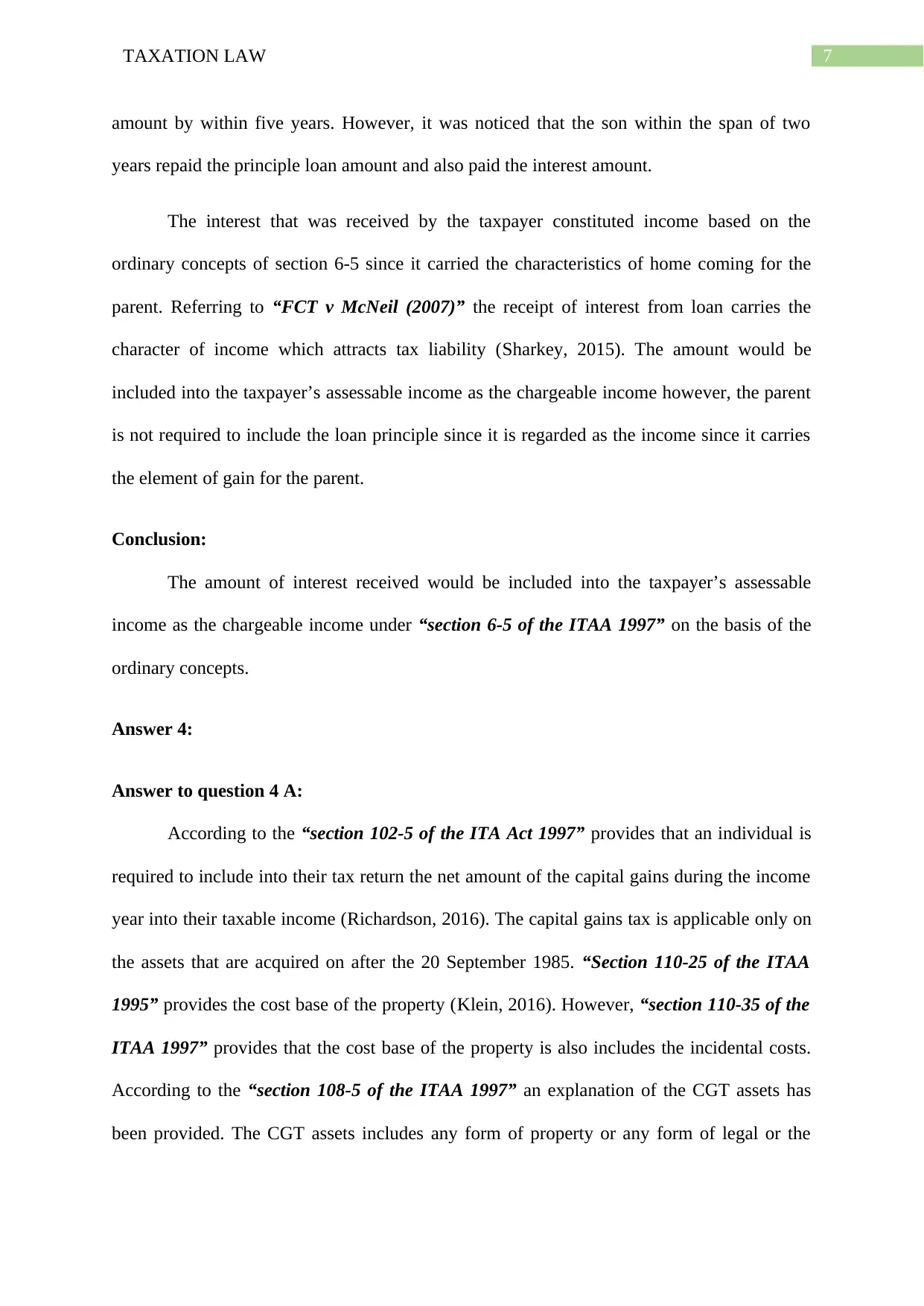
7TAXATION LAW
amount by within five years. However, it was noticed that the son within the span of two
years repaid the principle loan amount and also paid the interest amount.
The interest that was received by the taxpayer constituted income based on the
ordinary concepts of section 6-5 since it carried the characteristics of home coming for the
parent. Referring to “FCT v McNeil (2007)” the receipt of interest from loan carries the
character of income which attracts tax liability (Sharkey, 2015). The amount would be
included into the taxpayer’s assessable income as the chargeable income however, the parent
is not required to include the loan principle since it is regarded as the income since it carries
the element of gain for the parent.
Conclusion:
The amount of interest received would be included into the taxpayer’s assessable
income as the chargeable income under “section 6-5 of the ITAA 1997” on the basis of the
ordinary concepts.
Answer 4:
Answer to question 4 A:
According to the “section 102-5 of the ITA Act 1997” provides that an individual is
required to include into their tax return the net amount of the capital gains during the income
year into their taxable income (Richardson, 2016). The capital gains tax is applicable only on
the assets that are acquired on after the 20 September 1985. “Section 110-25 of the ITAA
1995” provides the cost base of the property (Klein, 2016). However, “section 110-35 of the
ITAA 1997” provides that the cost base of the property is also includes the incidental costs.
According to the “section 108-5 of the ITAA 1997” an explanation of the CGT assets has
been provided. The CGT assets includes any form of property or any form of legal or the
amount by within five years. However, it was noticed that the son within the span of two
years repaid the principle loan amount and also paid the interest amount.
The interest that was received by the taxpayer constituted income based on the
ordinary concepts of section 6-5 since it carried the characteristics of home coming for the
parent. Referring to “FCT v McNeil (2007)” the receipt of interest from loan carries the
character of income which attracts tax liability (Sharkey, 2015). The amount would be
included into the taxpayer’s assessable income as the chargeable income however, the parent
is not required to include the loan principle since it is regarded as the income since it carries
the element of gain for the parent.
Conclusion:
The amount of interest received would be included into the taxpayer’s assessable
income as the chargeable income under “section 6-5 of the ITAA 1997” on the basis of the
ordinary concepts.
Answer 4:
Answer to question 4 A:
According to the “section 102-5 of the ITA Act 1997” provides that an individual is
required to include into their tax return the net amount of the capital gains during the income
year into their taxable income (Richardson, 2016). The capital gains tax is applicable only on
the assets that are acquired on after the 20 September 1985. “Section 110-25 of the ITAA
1995” provides the cost base of the property (Klein, 2016). However, “section 110-35 of the
ITAA 1997” provides that the cost base of the property is also includes the incidental costs.
According to the “section 108-5 of the ITAA 1997” an explanation of the CGT assets has
been provided. The CGT assets includes any form of property or any form of legal or the
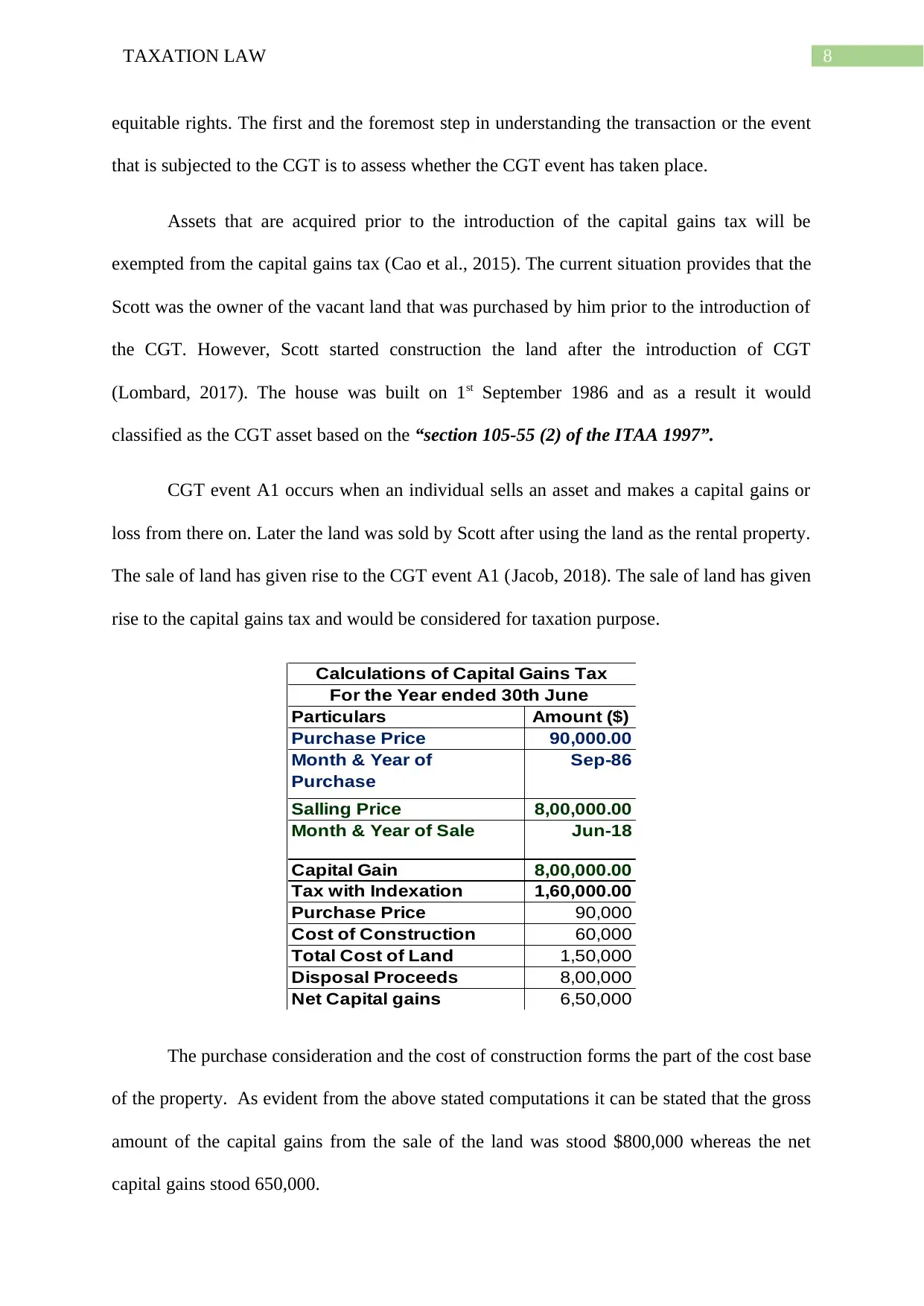
8TAXATION LAW
equitable rights. The first and the foremost step in understanding the transaction or the event
that is subjected to the CGT is to assess whether the CGT event has taken place.
Assets that are acquired prior to the introduction of the capital gains tax will be
exempted from the capital gains tax (Cao et al., 2015). The current situation provides that the
Scott was the owner of the vacant land that was purchased by him prior to the introduction of
the CGT. However, Scott started construction the land after the introduction of CGT
(Lombard, 2017). The house was built on 1st September 1986 and as a result it would
classified as the CGT asset based on the “section 105-55 (2) of the ITAA 1997”.
CGT event A1 occurs when an individual sells an asset and makes a capital gains or
loss from there on. Later the land was sold by Scott after using the land as the rental property.
The sale of land has given rise to the CGT event A1 (Jacob, 2018). The sale of land has given
rise to the capital gains tax and would be considered for taxation purpose.
Particulars Amount ($)
Purchase Price 90,000.00
Month & Year of
Purchase
Sep-86
Salling Price 8,00,000.00
Month & Year of Sale Jun-18
Capital Gain 8,00,000.00
Tax with Indexation 1,60,000.00
Purchase Price 90,000
Cost of Construction 60,000
Total Cost of Land 1,50,000
Disposal Proceeds 8,00,000
Net Capital gains 6,50,000
Calculations of Capital Gains Tax
For the Year ended 30th June
The purchase consideration and the cost of construction forms the part of the cost base
of the property. As evident from the above stated computations it can be stated that the gross
amount of the capital gains from the sale of the land was stood $800,000 whereas the net
capital gains stood 650,000.
equitable rights. The first and the foremost step in understanding the transaction or the event
that is subjected to the CGT is to assess whether the CGT event has taken place.
Assets that are acquired prior to the introduction of the capital gains tax will be
exempted from the capital gains tax (Cao et al., 2015). The current situation provides that the
Scott was the owner of the vacant land that was purchased by him prior to the introduction of
the CGT. However, Scott started construction the land after the introduction of CGT
(Lombard, 2017). The house was built on 1st September 1986 and as a result it would
classified as the CGT asset based on the “section 105-55 (2) of the ITAA 1997”.
CGT event A1 occurs when an individual sells an asset and makes a capital gains or
loss from there on. Later the land was sold by Scott after using the land as the rental property.
The sale of land has given rise to the CGT event A1 (Jacob, 2018). The sale of land has given
rise to the capital gains tax and would be considered for taxation purpose.
Particulars Amount ($)
Purchase Price 90,000.00
Month & Year of
Purchase
Sep-86
Salling Price 8,00,000.00
Month & Year of Sale Jun-18
Capital Gain 8,00,000.00
Tax with Indexation 1,60,000.00
Purchase Price 90,000
Cost of Construction 60,000
Total Cost of Land 1,50,000
Disposal Proceeds 8,00,000
Net Capital gains 6,50,000
Calculations of Capital Gains Tax
For the Year ended 30th June
The purchase consideration and the cost of construction forms the part of the cost base
of the property. As evident from the above stated computations it can be stated that the gross
amount of the capital gains from the sale of the land was stood $800,000 whereas the net
capital gains stood 650,000.
⊘ This is a preview!⊘
Do you want full access?
Subscribe today to unlock all pages.

Trusted by 1+ million students worldwide
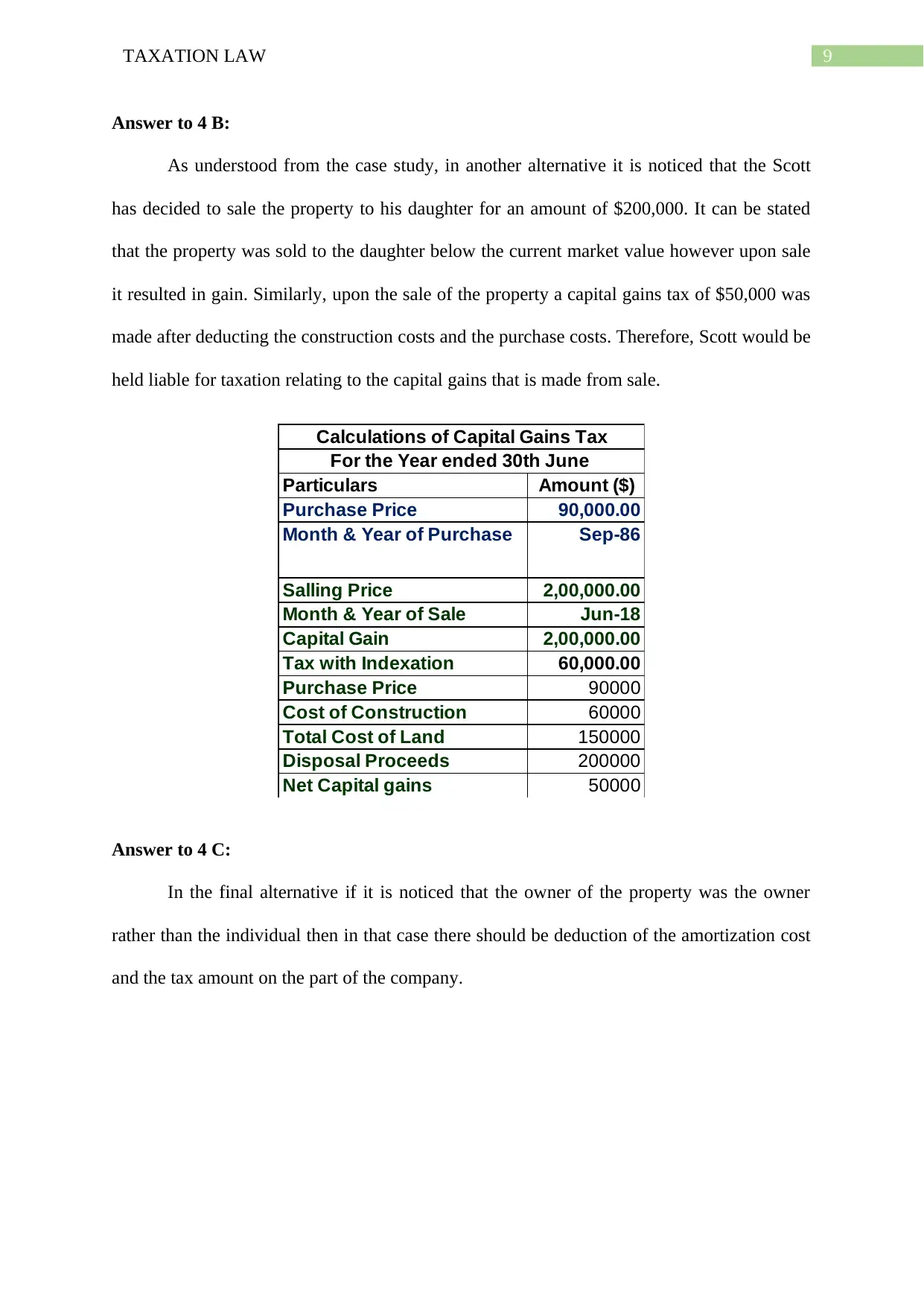
9TAXATION LAW
Answer to 4 B:
As understood from the case study, in another alternative it is noticed that the Scott
has decided to sale the property to his daughter for an amount of $200,000. It can be stated
that the property was sold to the daughter below the current market value however upon sale
it resulted in gain. Similarly, upon the sale of the property a capital gains tax of $50,000 was
made after deducting the construction costs and the purchase costs. Therefore, Scott would be
held liable for taxation relating to the capital gains that is made from sale.
Particulars Amount ($)
Purchase Price 90,000.00
Month & Year of Purchase Sep-86
Salling Price 2,00,000.00
Month & Year of Sale Jun-18
Capital Gain 2,00,000.00
Tax with Indexation 60,000.00
Purchase Price 90000
Cost of Construction 60000
Total Cost of Land 150000
Disposal Proceeds 200000
Net Capital gains 50000
Calculations of Capital Gains Tax
For the Year ended 30th June
Answer to 4 C:
In the final alternative if it is noticed that the owner of the property was the owner
rather than the individual then in that case there should be deduction of the amortization cost
and the tax amount on the part of the company.
Answer to 4 B:
As understood from the case study, in another alternative it is noticed that the Scott
has decided to sale the property to his daughter for an amount of $200,000. It can be stated
that the property was sold to the daughter below the current market value however upon sale
it resulted in gain. Similarly, upon the sale of the property a capital gains tax of $50,000 was
made after deducting the construction costs and the purchase costs. Therefore, Scott would be
held liable for taxation relating to the capital gains that is made from sale.
Particulars Amount ($)
Purchase Price 90,000.00
Month & Year of Purchase Sep-86
Salling Price 2,00,000.00
Month & Year of Sale Jun-18
Capital Gain 2,00,000.00
Tax with Indexation 60,000.00
Purchase Price 90000
Cost of Construction 60000
Total Cost of Land 150000
Disposal Proceeds 200000
Net Capital gains 50000
Calculations of Capital Gains Tax
For the Year ended 30th June
Answer to 4 C:
In the final alternative if it is noticed that the owner of the property was the owner
rather than the individual then in that case there should be deduction of the amortization cost
and the tax amount on the part of the company.
Paraphrase This Document
Need a fresh take? Get an instant paraphrase of this document with our AI Paraphraser
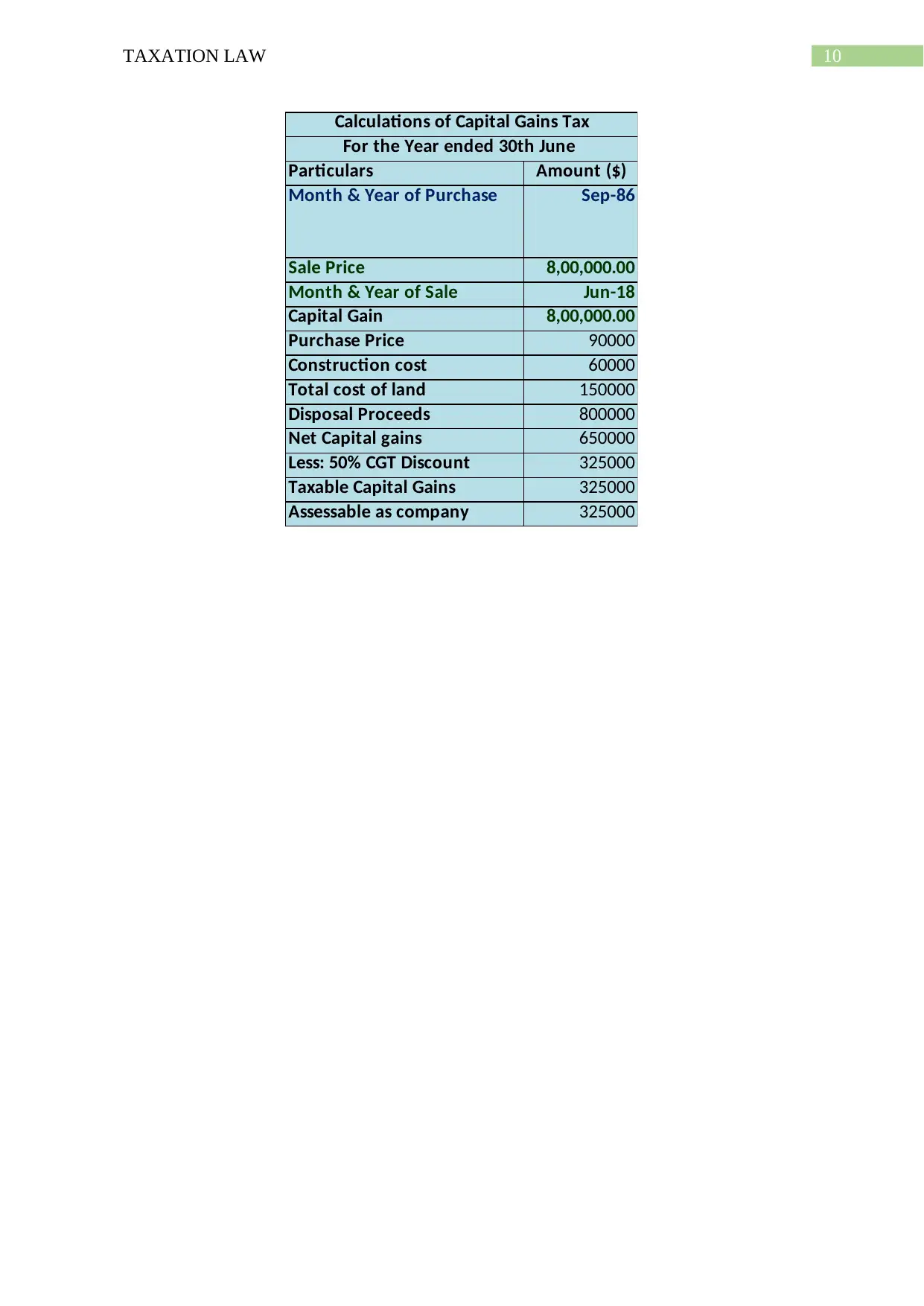
10TAXATION LAW
Particulars Amount ($)
Month & Year of Purchase Sep-86
Sale Price 8,00,000.00
Month & Year of Sale Jun-18
Capital Gain 8,00,000.00
Purchase Price 90000
Construction cost 60000
Total cost of land 150000
Disposal Proceeds 800000
Net Capital gains 650000
Less: 50% CGT Discount 325000
Taxable Capital Gains 325000
Assessable as company 325000
Calculations of Capital Gains Tax
For the Year ended 30th June
Particulars Amount ($)
Month & Year of Purchase Sep-86
Sale Price 8,00,000.00
Month & Year of Sale Jun-18
Capital Gain 8,00,000.00
Purchase Price 90000
Construction cost 60000
Total cost of land 150000
Disposal Proceeds 800000
Net Capital gains 650000
Less: 50% CGT Discount 325000
Taxable Capital Gains 325000
Assessable as company 325000
Calculations of Capital Gains Tax
For the Year ended 30th June
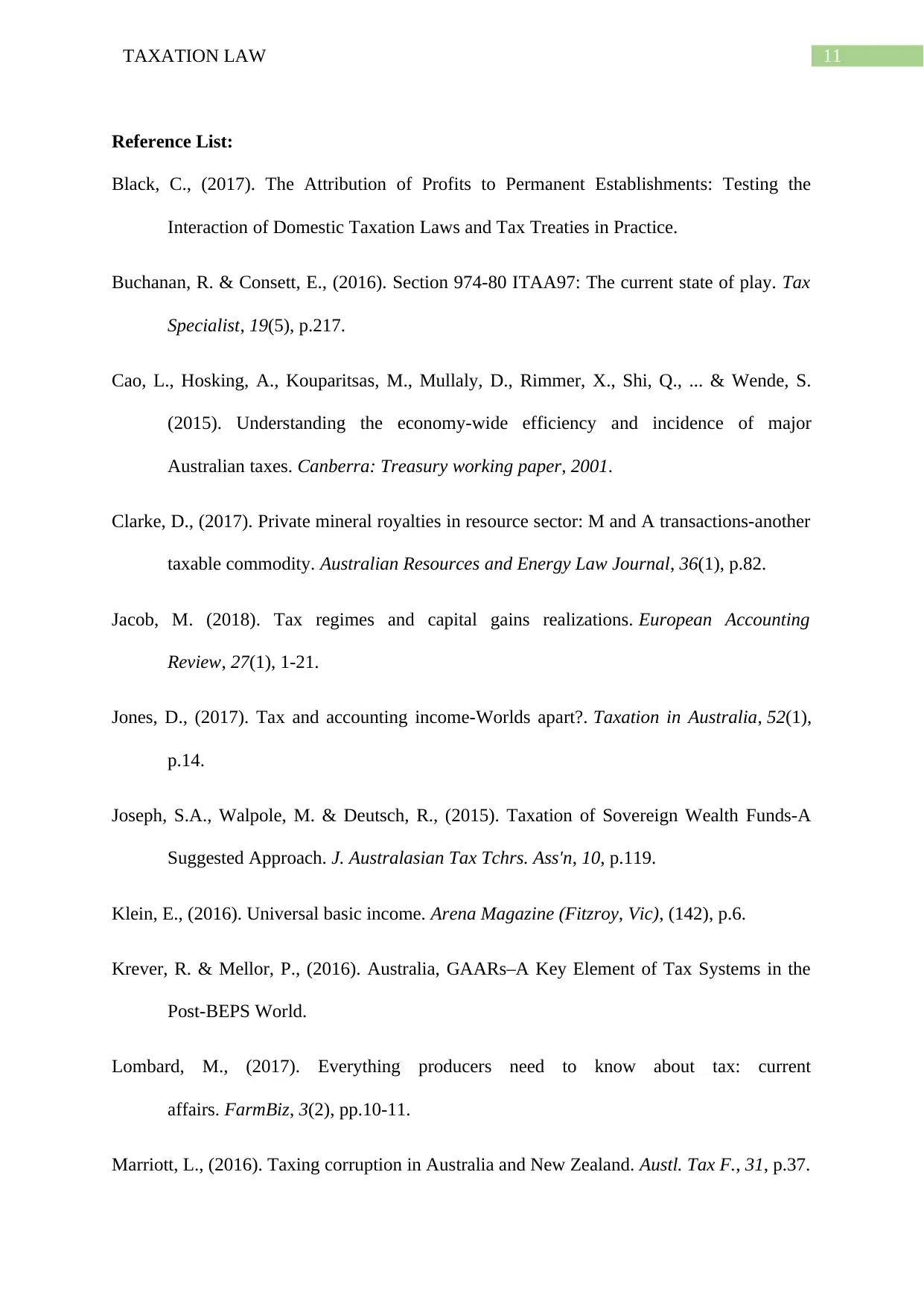
11TAXATION LAW
Reference List:
Black, C., (2017). The Attribution of Profits to Permanent Establishments: Testing the
Interaction of Domestic Taxation Laws and Tax Treaties in Practice.
Buchanan, R. & Consett, E., (2016). Section 974-80 ITAA97: The current state of play. Tax
Specialist, 19(5), p.217.
Cao, L., Hosking, A., Kouparitsas, M., Mullaly, D., Rimmer, X., Shi, Q., ... & Wende, S.
(2015). Understanding the economy-wide efficiency and incidence of major
Australian taxes. Canberra: Treasury working paper, 2001.
Clarke, D., (2017). Private mineral royalties in resource sector: M and A transactions-another
taxable commodity. Australian Resources and Energy Law Journal, 36(1), p.82.
Jacob, M. (2018). Tax regimes and capital gains realizations. European Accounting
Review, 27(1), 1-21.
Jones, D., (2017). Tax and accounting income-Worlds apart?. Taxation in Australia, 52(1),
p.14.
Joseph, S.A., Walpole, M. & Deutsch, R., (2015). Taxation of Sovereign Wealth Funds-A
Suggested Approach. J. Australasian Tax Tchrs. Ass'n, 10, p.119.
Klein, E., (2016). Universal basic income. Arena Magazine (Fitzroy, Vic), (142), p.6.
Krever, R. & Mellor, P., (2016). Australia, GAARs–A Key Element of Tax Systems in the
Post-BEPS World.
Lombard, M., (2017). Everything producers need to know about tax: current
affairs. FarmBiz, 3(2), pp.10-11.
Marriott, L., (2016). Taxing corruption in Australia and New Zealand. Austl. Tax F., 31, p.37.
Reference List:
Black, C., (2017). The Attribution of Profits to Permanent Establishments: Testing the
Interaction of Domestic Taxation Laws and Tax Treaties in Practice.
Buchanan, R. & Consett, E., (2016). Section 974-80 ITAA97: The current state of play. Tax
Specialist, 19(5), p.217.
Cao, L., Hosking, A., Kouparitsas, M., Mullaly, D., Rimmer, X., Shi, Q., ... & Wende, S.
(2015). Understanding the economy-wide efficiency and incidence of major
Australian taxes. Canberra: Treasury working paper, 2001.
Clarke, D., (2017). Private mineral royalties in resource sector: M and A transactions-another
taxable commodity. Australian Resources and Energy Law Journal, 36(1), p.82.
Jacob, M. (2018). Tax regimes and capital gains realizations. European Accounting
Review, 27(1), 1-21.
Jones, D., (2017). Tax and accounting income-Worlds apart?. Taxation in Australia, 52(1),
p.14.
Joseph, S.A., Walpole, M. & Deutsch, R., (2015). Taxation of Sovereign Wealth Funds-A
Suggested Approach. J. Australasian Tax Tchrs. Ass'n, 10, p.119.
Klein, E., (2016). Universal basic income. Arena Magazine (Fitzroy, Vic), (142), p.6.
Krever, R. & Mellor, P., (2016). Australia, GAARs–A Key Element of Tax Systems in the
Post-BEPS World.
Lombard, M., (2017). Everything producers need to know about tax: current
affairs. FarmBiz, 3(2), pp.10-11.
Marriott, L., (2016). Taxing corruption in Australia and New Zealand. Austl. Tax F., 31, p.37.
⊘ This is a preview!⊘
Do you want full access?
Subscribe today to unlock all pages.

Trusted by 1+ million students worldwide
1 out of 13
Related Documents
Your All-in-One AI-Powered Toolkit for Academic Success.
+13062052269
info@desklib.com
Available 24*7 on WhatsApp / Email
![[object Object]](/_next/static/media/star-bottom.7253800d.svg)
Unlock your academic potential
Copyright © 2020–2025 A2Z Services. All Rights Reserved. Developed and managed by ZUCOL.





